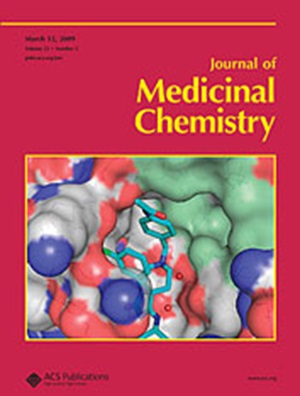Discovery of FHD-286, a First-in-Class, Orally Bioavailable, Allosteric Dual Inhibitor of the Brahma Homologue (BRM) and Brahma-Related Gene 1 (BRG1) ATPase Activity for the Treatment of SWItch/Sucrose Non-Fermentable (SWI/SNF) Dependent Cancers
IF 6.8
1区 医学
Q1 CHEMISTRY, MEDICINAL
Journal of Medicinal Chemistry
Pub Date : 2025-01-12
DOI:10.1021/acs.jmedchem.4c0253510.1021/acs.jmedchem.4c02535
引用次数: 0
Abstract
BRM (SMARCA2) and BRG1 (SMARCA4) are mutually exclusive ATPase subunits of the mSWI/SNF (BAF) chromatin remodeling complex. BAF is an attractive therapeutic target because of its role in transcription, and mutations in the subunits of BAF are common in cancer and neurological disorders. Herein, we report the discovery of compound 1 (FHD-286) as a potent allosteric inhibitor of the dual ATPase subunits from a high-throughput screening hit with a BRM IC50 of ∼27 μM. FHD-286 is an orally bioavailable compound with antitumor activity in mouse xenograft models of uveal melanoma and acute myeloid leukemia and is being evaluated in Phase 1 clinical trials.

发现FHD-286,一种一流的口服生物有效的Brahma同源物(BRM)和Brahma相关基因1 (BRG1) atp酶活性的变构双重抑制剂,用于治疗开关/蔗糖不可发酵(SWI/SNF)依赖性癌症
BRM (SMARCA2)和BRG1 (SMARCA4)是mSWI/SNF (BAF)染色质重塑复合体中互斥的atp酶亚基。由于其在转录中的作用,BAF是一个有吸引力的治疗靶点,而BAF亚基的突变在癌症和神经系统疾病中很常见。在此,我们报告了化合物1 (FHD-286)作为双atp酶亚基的有效变构抑制剂的发现,其高通量筛选命中的BRM IC50为~ 27 μM。FHD-286是一种口服生物利用化合物,在葡萄膜黑色素瘤和急性髓系白血病的小鼠异种移植模型中具有抗肿瘤活性,目前正在进行1期临床试验评估。
本文章由计算机程序翻译,如有差异,请以英文原文为准。
求助全文
约1分钟内获得全文
求助全文
来源期刊

Journal of Medicinal Chemistry
医学-医药化学
CiteScore
4.00
自引率
11.00%
发文量
804
审稿时长
1.9 months
期刊介绍:
The Journal of Medicinal Chemistry is a prestigious biweekly peer-reviewed publication that focuses on the multifaceted field of medicinal chemistry. Since its inception in 1959 as the Journal of Medicinal and Pharmaceutical Chemistry, it has evolved to become a cornerstone in the dissemination of research findings related to the design, synthesis, and development of therapeutic agents.
The Journal of Medicinal Chemistry is recognized for its significant impact in the scientific community, as evidenced by its 2022 impact factor of 7.3. This metric reflects the journal's influence and the importance of its content in shaping the future of drug discovery and development. The journal serves as a vital resource for chemists, pharmacologists, and other researchers interested in the molecular mechanisms of drug action and the optimization of therapeutic compounds.
 求助内容:
求助内容: 应助结果提醒方式:
应助结果提醒方式:


